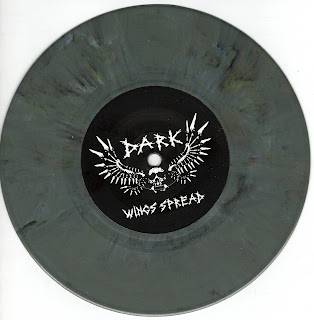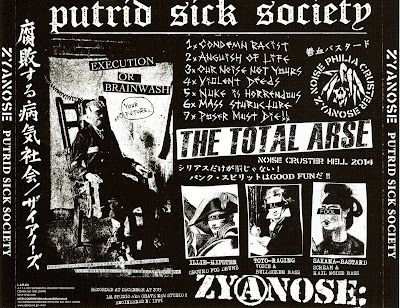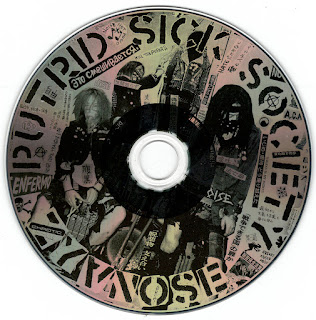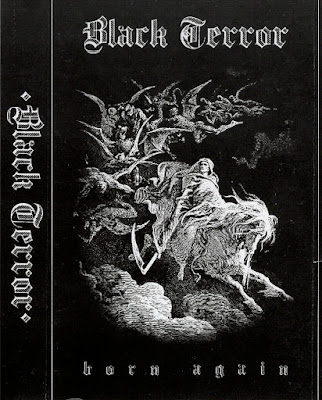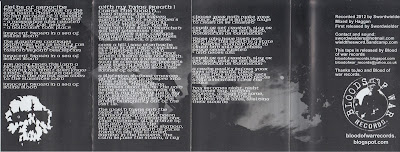As logical as it might seem, on the surface, to approach this Ep through the prism of the short but meaningful late 00's/early 10's revival of the vintage anarcho sound of bands like Surrender, Vivid Sekt or OK?, it would not be relevant. The latter was mostly an American phenomenon (1981 being a crucial exception) that must be seen in the broader context of a limited renewed interest in the British punk-rock sound, including so-called UK82 and oi, permeating a new generation of punks in North America. Arguably, the bands paying tribute to the "classic sound" at that point in time were referring to a set of specific bands that had been picked to stand for a typical, if not generic, sound. Not that this was bad in itself, on the contrary, I love typical bands like Alternative, Flux or indeed Anthrax and when you heard of a band that was said to be influenced by old-school anarchopunk you expected some a number of similar elements in terms of songwriting and tones. And visuals obviously. You've got to have at least 6 doves in order to be a proper anarcho band.
I suppose the work of Lance Hahn (tragically his book Let the Tribes Increase never saw the light of day) and Ian Glasper meaningfully contributed to rekindle the interest in the old anarchopunk bands and bring attention to many obscure ones as well (who had really heard of Reality Control, The Sears or Lack of Knowledge outside of the old-timers?). I would venture that the creative drive of the previously mentioned bands (and of others later on) could be located at the metting point of these dynamics, between a sonic trend and exhaustive documentation of the scenes, not to mention the internet that allowed all of this to circulate easily. I will probably do a series about such bands at some point.
Anthrax were always an interesting case to me. They could not be said to belong in the "obscure bands" category (they did have an Ep on Crass Records) but they were not part of the "famous bands" category either (no one could really identify my Anthrax shirt when I first bought one in the mid-00's which made me feel special and even smugger than usual). In fact, I remember asking many an old local punk when I first heard of their existence and no one really knew who I was talking about (or at least they pretended not to, probably because I was very annoying and obstinate, or it may have had to do with the fact that we have a poor punk culture in France). I was finally able to get hold of a cheap cdr discography for a couple of quids and instantly loved them but still they had that mid-table feel, maybe because they did not have a chance to record a full album then (many did not).
It was also around that time, in the early 10's, that many old anarcho bands started to reform - not always for the best I hate to admit. It is pretty obvious that the renewed interest prompted bands that thad been dead for decades to give it another go. I mean, if people suddenly started raving about my old shite bands I would probably consider getting the band back. This time around we might actually get petrol money at gigs. Anthrax undeniably stood as one of the best and most genuine bands in that category. I was enthralled when in 2007, out of nowhere as far as I could tell, a cd discography was released, with a much better sound than the crappy cdr I had (a vinyl version would appear in 2009), that made me think that few bands could claim to be able to sound as snotty and tuneful at the same time as Anthrax. I suppose the reissue was another step toward the proper reformation of the band that materialized with the One Last Drop Ep released in 2011 as a benefit for the mighty 1 in 12 Club in Bradford. The fact that the discography and the new record had the same title and cover (that looks ace and I love how it connects visually and topically with Capitalism is Cannibalism) was a bit confusing but it was a very strong come-back of old-school punk-rock with political lyrics. The band finally released their first album in 2012 entitled All For the Cause which was the first release of the new label Grow Your Own Records run by Gary from Anthrax that epitomises what autonomous DIY punk really means and has become quite prolific with records from anarcho-boomers as well as younger bands and overall a very positive and constructive energy. I don't like everything the label puts out but there are some genuine gems.
By the mid 10's we all understood that Anthrax were here to stay and the surprise of the reformation had somehow faded, allowing one to be more objective. I love the song "The beg society", a reference to Tory Cameron's concept of Big Society that already seems far away in 2024 given all the shits the UK went through in the past ten years. It has everything you want and expect from an anthemic punk song, one you'll be humming all day, whether in the bathroom, at work or, more worryingly, in your sleep. Many reformed bands try to get a clean, polished, well-produced sound for their new recordings because they never had the chance to in the first place whereas the "fans" who often discovered the bands through the internet precisely crave for the original cheaper sound as if the bands had been stored in a freezer for 30 years ready to be resurrected, untouched like mammoths although not as hairy. Anthrax find the perfect balance between their old punk sound and a more powerful production. As I said, the song is perfect: catchy singalong chorus, angry vocals that manage to carry tunes and emotions, a classic punk-rock riff enhanced with a moody, darker lead with the song guitar, lyrics anchored in their time. It's a great show of snotty punk with an angry melody and not everyone can pull it out that well. I am reminded of the moodier numbers of The System, Red Flag 77 or 90's Riot/Clone, this kind of well-written distinctly British old-school punk. A definite win.
On the other side you've got two songs from Burnt Cross, a band, or rather a studio project, done by two brothers that proved to be extremely prolific during their 10 year tenure, possibly too much for me as I have had trouble to catch up with all the records they released. The band seemingly crashed into the scene out of nowhere, taking anarchopunk devotees by storm. I remember listening to their Carcass of Humanity cd almost expecting it to be... well, a bit shit. It was described by a friend as "anarchopunk with a drum machine" and, let's face it, beside the amazing Cress, almost no band has been able to deliver properly with such a concept. We have a strong relationship with drum machines in punk bands in France (I would personally rather call it a trauma or a vile addiction) and, in fact, before all the oi revival (also known as The Fall) France was a place known for its drum machines. I have seen a lot of cheap drum machine punk bands in my youth and let me tell you that I'm still scarred so whenever I hear of a drum machine in a band, it triggers my defense mechanism immediately. I was not therefore expecting much from Burnt Cross. And of course, my narrow-mindedness and prejudices were quickly proven wrong and wept away upon listening to the thing, a minimalistic anarcho sound that blended Conflict and Cress but miraculously worked. On paper, it should not and some songs on the first recordings do walk on the thin edge between the boring and tedious category and the angry and catchy one, but there was always a hook, a tune, a chorus, something that made them great against all odds.
The band significantly improved with each release and recorded a number of incredible anarchopunk songs that were just so unique at the time (The Next World did use a drum machine but their creative intent was totally different) and still are to a large extent. No one, beside Cress, really did that specific style of simple but energetic punk with that furious half-spoken half-shouted vocal delivery conveying a sense of (out)rage and threat and cracking melodies to keep things memorable. In Burnt Cross' case, less was certainly more and the fact the songwriting was just a two person entreprise probably helped in making the whole coherent and very focused (there was no half-demented bass player begging to do a solo for instance). The two numbers on this one, "Anathema" and "The inner revolutionist" clearly belonged to the top shelf works of the band. The first one has guest vocals from Maureen which gives the song the delicious classic male/female vocals touch that defines anarchopunk. Here I am reminded of The Mad Are Sane or Conflict, of course, but 90's US anarcho bands like Mankind? or Resist and Exist are certainly not far away. The second song is a darker mid-paced one reminiscent of Icons of Filth or Exit-Stance with brilliant, almost postpunk, guitar leads demonstrating the band's seemingly effortless sense of tune. Angry songs and bitter words. Cracking stuff from a band that existed outside of trends and delivered referential anarchopunk music (all the elements that made the style distinct are present) that was genuine and not prompted by a trend.
This split can be said to be a minor anarchopunk classic and I cannot think of a superior split in this category in the last decade. It was co-released in 2014 by 15 (!) DIY labels and there were 1000 copies of the thing so you can probably find a copy if you bother to look.












